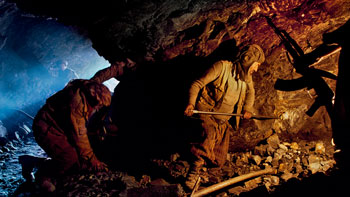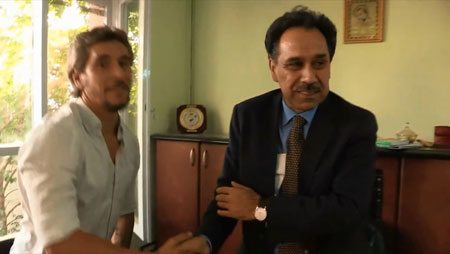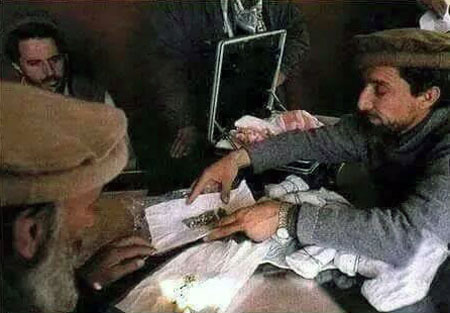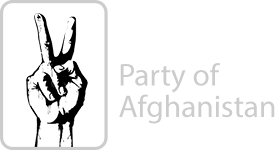Documentary reveals plunder of billion-dollar mines in Panjshir Province
- Category: Articles
- Written by Ahmar
- Published: Wednesday, 15 July 2015

The underground wealth of Afghanistan is estimated to be worth more than 1 trillion (1,000,000,000,000) dollars. Some experts believe it is several times more than this amount. In an article on the mines of Afghanistan, Professor Michel Chossudovsky quotes the analysis by the World Bank and writes: “…the Ainak copper production alone could eventually capture as much as 2 percent of the annual world market.” He further adds:
“Geological surveys conducted by the Soviet Union in the 1970s and early 1980s confirm the existence of vast reserves of copper (among the largest in Eurasia), iron, high grade chrome ore, uranium, beryl, barite, lead, zinc, fluorspar, bauxite, lithium, tantalum, emeralds, gold and silver. (Afghanistan, Mining Annual Review, The Mining Journal, June, 1984). These surveys suggest that the actual value of these reserves could indeed be substantially larger than the one trillion dollars “estimate” intimated by the Pentagon-USCG-USAID study.”
Afghanistan is rich in emeralds which is the second most valuable stone after diamonds. Afghanistan’s emerald is among the best in the world with Colombia and Brazil coming second and third respectively. No emerald in the world is as green and crystalline as Afghanistan’s. The mining of emeralds has only started in the past few decades when Ahmad Shah Massoud ordered the extraction and smuggling of these precious stones from the mountains of Panjshir.
In the documentary Afghanistan's ‘Hidden Gems: Wild Angle’, two French filmmakers Eric De Lavarène and Véronique Maudu visit the mines of Panjshir along with French emerald dealer Raphael Chahboub who is a former soldier who had worked in Afghanistan. This documentary exposes several aspects of the horrors of this business like the plight of the miners, the cruel manner of this extraction, the huge profits the mafia, especially the Shura-e-Nizar (military faction of Jamiat-e-Islami, founded by Ahmad Shah Massoud), gains from this business.
In this documentary, which was also aired by Al Jazeera English, it is claimed that the emeralds are mostly smuggled through Pakistan and India and earns these greedy smugglers some 150 million dollars every year. If this industry is run professionally it can have an income of almost a billion dollars for the government, but because this business is in the hands of Shura-e-Nizar, this money only fattens the pockets of this group’s people. The extraction in these mines takes place without a representative of the Ministry of Mines and none of the dealers, from the smallest to the biggest ones, report to the government.

Ahmad Wali Massoud meeting with Raphael Chahboub in Massoud Foundation office.
When Raphael Chahboub wants to visit the emerald mines in Panjshir he goes to meet Ahmad Wali Massoud (Ahmad Shah Massoud’s brother) in his office in Massoud Foundation to take permission for the visit. Ahmad Wali Massoud assures Raphael, “So anything you like, want us to do, say for the people here in the [Massoud] Foundation, so they can help you. What is here, or any other province or Panjshir or anywhere. So, we are here to help.”

Mohammad Gul who used to be Ahmad Shah Massoud’s driver started dealing emeralds on Massoud’s orders, which has today turned into a huge business in Afghanistan.
Then the filmmakers search for the emerald business tycoon who is called Mohammad Gul. Mohammad Gul introduces himself as the former driver of Ahmad Shah Massoud and shows photos of his younger days with Massoud. He says that in the 1980s, Massoud had assigned him the duty of taking emeralds from miners and selling it abroad. Today Gul is a wealthy businessman and believes this business belongs to him. He has monopolized a major part of the emerald market and sets the prices of rubies, sapphires, and emeralds.

Photo showing Ahmad Shah Massoud selling precious stones.
In this documentary there are several scenes which show the pain and suffering of the miners. The miners are forced to work for eighteen hours every day, far from their homes. They dig at the hearts of the mountains in the most insecure conditions, work in so much dust and pollution that even their eyes have rings of dust around them, and risk their lives while blowing up rocks in the mines. These miners suffer from fatal respiratory and kidney diseases. With all these hardships they earn only about 3,500 AFS (58 USD) per week.
In all this turmoil, the Ministry of Mining sits indifferently, with a spokesperson who only knows how to dress well like all the spokespersons of the government. He simply parrots several articles of the law and nothing more. On June 23, 2015, Tolo TV reported that currently an area of 3000 mines is being plundered by ‘armed groups’.
This documentary explores a small section of the abundant underground resources of Afghanistan which is plundered by warlords who fear no accountability for looting these national assets. These mines have drawn powerful countries to Afghanistan and till the day this puppet regime is the ruler of our ill-fated nation, it seems that this situation will continue.
Part 1
Part 2











